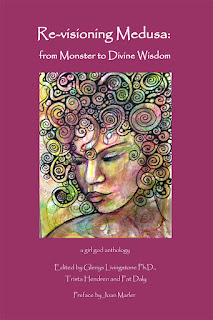 |
| Painting by Arna Baartz |
Pegasus is a symbol of spiritual elevation, transformation, and transcendence. I always knew that Pegasus was born out of Medusa’s blood but I didn’t know the entire story. I followed that trail of blood toward a richer, deeper understanding of female power. When I read Barbara Walker’s Women’s Encyclopedia of Myths and Secrets, I discovered a complex and more meaningful narrative. Long ago, Medusa was the serpent-goddess of the Libyan Amazon. She represented female wisdom as the destroyer aspect of the Triple Goddess, Virgin-Mother-Crone. She was similar to Kali Ma, the Hindu Triple Goddess of creation, preservation and destruction.
A Gorgon was a monstrous female creature within the complicated pantheon of Greek gods and goddesses. Her face would turn anyone who laid eyes upon it to stone. Gorgons were hideous beings with impenetrable scales, hair of living snakes, hands made of brass and sharp fangs. They guarded the entrance to the underworld. A stone head or picture of a Gorgon was often placed or drawn on temples to avert the dark forces of evil. Medusa was one such Gorgon.
Medusa embodied the principle of medha, the Indo-European root word for female wisdom. Pegasus was named for the Pegae, water priestesses who tended the sacred spring of Pirene in Corinth, Greece. Pegasus represented divine inspiration. His crescent moon-shaped hoof stamped the ground and dug the Hippocrene (Horse-Well), a spring of poetic inspiration on Mount Helicon, the home of the Muses.
In a late version of the Medusa myth, related by the Roman poet Ovid (Metamorphoses 4.770), Medusa is a ravishingly beautiful maiden, “the jealous aspiration of many suitors.” Poseidon rapes Medusa in Athena’s temple. The enraged Athena transforms Medusa’s beautiful hair into serpents and makes her face so terrible to behold that the mere sight of it turns onlookers to stone.
King Polydectes, the ruler of Seriphos, enters the story. He wants to marry Danaë, the only child of the king of Argos; however, her son, Perseus, doesn’t approve. In an effort to get rid of Perseus, the king sends him to fetch Medusa’s head, expecting him to die. Athena assists Perseus by giving him a mirrored shield. He views Medusa’s reflection in the shield and cuts off her head. Immediately, Pegasus springs from Medusa’s blood.
This latter version of the story is disturbing in that Medusa is blamed and punished by Athena even though she is Poseidon’s victim. In another twist, Athena co-opts Medusa’s power by placing Medusa’s face upon her shield. Yet, after many millennia, Medusa remains a compelling symbol of wild female power. Paradoxically, she is a dangerous, unruly woman who invokes fear and she is also a potent image of inner strength for women.
Wild women are condemned as corrupt, depraved, immoral, sinful, wanton, and wicked. Women who live in a state of nature, not tamed or domesticated, are unruly, ungovernable, visionary, savage, and ferocious. These derogatory labels teach us to fear each other, our power, and to deny our inner wisdom. Strong-willed women are demonized in the patriarchal system and socialized to behave.
An excerpt from Loran's essay in Re-visioning Medusa: from Monster to Divine Wisdom
 |
| Order here. |
Comments
Post a Comment